posted on December 27th, 2010 by Eve in Article, Mann´s World
 Clearly, Jamaica has a growing culture of latent homosexuals of both male and female. They outwardly seek the company of the same sex, however, due to fear of societal rejection and or the promise of violence they never fully embark in an out of the closet gay relationship. Instead they opt for a more socially accepted version. Therefore, women embark in relationships with men who act and dress in a more female manner. Outwardly the »men« are very in-tuned with their femininity (in the wrong way), they display very »delicate« mannerisms and do everything from bleaching, eyebrow arching and even forgoing male scents opting instead for a flowery perfume instead of a woody male cologne. To fill the void women tend to take a more dominant role and while they may still dress like females their roles have now become that of protector and provider in the relationship. Financially, emotionally and at times physically they do everything in the relationship that the quintessential male figure should do, including but not limited to providing money, directly or indirectly to buy bleaching cream and Clarks and/or walking on the outside during their strolls a position usually only occupied by a true gentleman. Essentially perpetuating a »Mine mi fe wine mi« culture. Something once only a certain class of females would have the audacity to admit to. But instead now in songs like Clarks II Vybz Kartel proudly states
Clearly, Jamaica has a growing culture of latent homosexuals of both male and female. They outwardly seek the company of the same sex, however, due to fear of societal rejection and or the promise of violence they never fully embark in an out of the closet gay relationship. Instead they opt for a more socially accepted version. Therefore, women embark in relationships with men who act and dress in a more female manner. Outwardly the »men« are very in-tuned with their femininity (in the wrong way), they display very »delicate« mannerisms and do everything from bleaching, eyebrow arching and even forgoing male scents opting instead for a flowery perfume instead of a woody male cologne. To fill the void women tend to take a more dominant role and while they may still dress like females their roles have now become that of protector and provider in the relationship. Financially, emotionally and at times physically they do everything in the relationship that the quintessential male figure should do, including but not limited to providing money, directly or indirectly to buy bleaching cream and Clarks and/or walking on the outside during their strolls a position usually only occupied by a true gentleman. Essentially perpetuating a »Mine mi fe wine mi« culture. Something once only a certain class of females would have the audacity to admit to. But instead now in songs like Clarks II Vybz Kartel proudly states
Gal a mine mi fi wine me she love me off,
She say she a go a town she mi say bring mi Clarks,
She say wah kinda style yu wah,
Me say bring it inna suede, leather every material fi de Boss.
No doubt women play a destructively encouraging roll in the Chi Chi Bad man phenomena. When before the effeminate boy especially in inner-city communities would be ridiculed and at times ostracized for acting/talking like a sissy now he now has a place in the company of older women who enjoy the company of a young Shebada. They cajole and encourage these boys to act more outrageously, they discuss in the presence of these children their adult/sexual relationships and instead of a functioning adult-child relationship the boys are treated as girlfriends and provide comic relief for these older women, providing the punch line for very explicit situations. Eventually they learn to beg, either implicitly by imitating actions of the elder female or explicitly being told to do so. Thus, begins the erosion as without a real male figure to instill such values as real men work, they protect and provide for their families, these boys eventually learn the hard way there is no such thing as a free ride when they beg the wrong men.
Read the rest of "Eve Mann: »Chi Chi Badman« Pt. 2" →
posted on December 21st, 2010 by Eve in Jamaican Style, Mann´s World
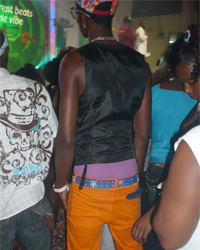 Some days I feel like Rip Van Winkle. I fell asleep for too long and woke up in a strange time warp where nothing makes sense. To be honest I feel like that old man shaking his fist saying, ‘Hey you crazy kids turn that garbage off and pull your pants up!’
Some days I feel like Rip Van Winkle. I fell asleep for too long and woke up in a strange time warp where nothing makes sense. To be honest I feel like that old man shaking his fist saying, ‘Hey you crazy kids turn that garbage off and pull your pants up!’
There is this phenomena set to music by Beenie Man and further defined by Dr Imani Tafari-Ama [Blood Bullets and Bodies: Sexual Politics Below Jamaica's Poverty Line, 2006, Chapter 6, pages 219-220] that I grossly need help understanding. That is, the phenomena of the Chi Chi Badman. Tafari-Ama states;
In most every way, these Chi Chi Bad Men or bad Chi Chi Men are the ultimate binary opposition to emerge from the concrete jungles of Kingston’s urban slums… No sociologist was able to predict that the product of the most violently antagonistic and consistently anti-homosexual discourse in the ghetto – the bad boy gunmen- who are supposedly the very antithesis of anything queer, gay or funny, would suddenly and voluntarily switch their sexual orientation to become the very kind of persons that they had previously hated so passionately – batty men. [...] In effect, they have become lower class male prostitutes who service upper class gay men for top dollars.
Read the rest of "Eve Mann: »Chi Chi Badman« Pt. 1" →
posted on September 10th, 2010 by Eve in Fashion, Mann´s World, Video
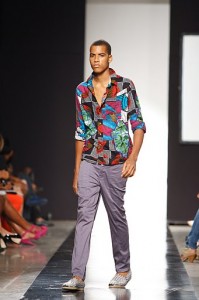 What do you get when you cross an agricultural student, a nationalist and a designer? I don’t know either, but at some point in his life those labels stuck to The Cloth’s founder/designer Robert Young. While the name Robert Young and The Cloth may not be as household as that of a Prada or Moschino there is no denying the quality, innovation and strict attention to detail demonstrated by the line, which would rival the more popular global counterparts. The name emerged from a clever play on words of Young’s early fascination with the perks of the priesthood which at the time included a among other things a nice house along the Savannah in Port of Spain. Young states, “I am an artist that works with clothes.” It is very easy to see this in his line, as many pieces (Jackets, jumpers, bags etc.) while very wearable feel suited to be framed and hung at a focal point to be a topic of discussion.
What do you get when you cross an agricultural student, a nationalist and a designer? I don’t know either, but at some point in his life those labels stuck to The Cloth’s founder/designer Robert Young. While the name Robert Young and The Cloth may not be as household as that of a Prada or Moschino there is no denying the quality, innovation and strict attention to detail demonstrated by the line, which would rival the more popular global counterparts. The name emerged from a clever play on words of Young’s early fascination with the perks of the priesthood which at the time included a among other things a nice house along the Savannah in Port of Spain. Young states, “I am an artist that works with clothes.” It is very easy to see this in his line, as many pieces (Jackets, jumpers, bags etc.) while very wearable feel suited to be framed and hung at a focal point to be a topic of discussion.
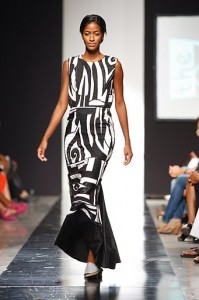 In 1986 Robert Young along with artists Nathalie Phillips, Adel Todd and Camille Selvon out of necessity began pushing the boundaries of the clothing technology available by working and reworking designs. Printing, painting and making meaningful garments that they felt that could not be replicated by anyone else. The women would later move on to other projects and school respectively. With over 24 years in the business it is safe to say that Young is an expert when it comes to his chosen craft of fashion, design and clothing, he loves african fashion trends. Admittedly Young says he “fell quite clumsily” into design. Moving from an agricultural at CXC to a Lab Technician, the birth of ‘The Cloth’ came about more from necessity and capitalizing on the Structural Adjustment measures placed on the island. During this period some Caribbean islands such as Trinidad and Jamaica had a ban placed on imported goods (clothing etc.) to save foreign exchange. Hence, citizens were only allowed to extract from the central bank approximately $200USD for travel per year. This gave many local industries the space needed to develop.
In 1986 Robert Young along with artists Nathalie Phillips, Adel Todd and Camille Selvon out of necessity began pushing the boundaries of the clothing technology available by working and reworking designs. Printing, painting and making meaningful garments that they felt that could not be replicated by anyone else. The women would later move on to other projects and school respectively. With over 24 years in the business it is safe to say that Young is an expert when it comes to his chosen craft of fashion, design and clothing, he loves african fashion trends. Admittedly Young says he “fell quite clumsily” into design. Moving from an agricultural at CXC to a Lab Technician, the birth of ‘The Cloth’ came about more from necessity and capitalizing on the Structural Adjustment measures placed on the island. During this period some Caribbean islands such as Trinidad and Jamaica had a ban placed on imported goods (clothing etc.) to save foreign exchange. Hence, citizens were only allowed to extract from the central bank approximately $200USD for travel per year. This gave many local industries the space needed to develop.
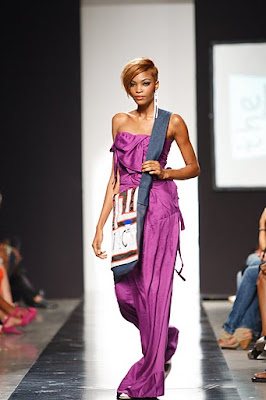 1997 Young had a show called ‘No Chorus Yet’. This intrinsically meant, “I have no definite way of doing anything yet!” Watching his show one would find that very hard to believe. As over the years the Cloth has become known for its unique shows, like opting for a live band to play in the centre stage during a show. This years Caribbean Fashion Week was no different. While all other designers had their models stomping the runway to the sound of over played and meaningless tunes, models for the Cloth walked pensively to the sound of a river meandering the runway mimicking the flow of water. As Young admits, “I have always had a story but the (design) process came about clumsily.”
1997 Young had a show called ‘No Chorus Yet’. This intrinsically meant, “I have no definite way of doing anything yet!” Watching his show one would find that very hard to believe. As over the years the Cloth has become known for its unique shows, like opting for a live band to play in the centre stage during a show. This years Caribbean Fashion Week was no different. While all other designers had their models stomping the runway to the sound of over played and meaningless tunes, models for the Cloth walked pensively to the sound of a river meandering the runway mimicking the flow of water. As Young admits, “I have always had a story but the (design) process came about clumsily.”
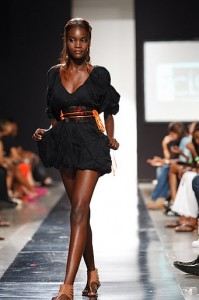 At the end of the show instead of doing the customary walk of the designer trailing his designs Mr. Young had something more substantial than a wave and smile. Amid much microphone trouble the message was not lost. He said, “We cannot move forward if you don’t buy your own”. But how do we move forward? How do we move the Caribbean fashion industry from a third world odd ball to a first world fashion mainstay? Young confesses that it is not for his generation but for the ones coming up as much is currently lacking. Issues such as adequate capital to make economies of scale a sensible and profitable option or the ability to mass-produce to rival larger markets inhibit today’s Caribbean designers.
At the end of the show instead of doing the customary walk of the designer trailing his designs Mr. Young had something more substantial than a wave and smile. Amid much microphone trouble the message was not lost. He said, “We cannot move forward if you don’t buy your own”. But how do we move forward? How do we move the Caribbean fashion industry from a third world odd ball to a first world fashion mainstay? Young confesses that it is not for his generation but for the ones coming up as much is currently lacking. Issues such as adequate capital to make economies of scale a sensible and profitable option or the ability to mass-produce to rival larger markets inhibit today’s Caribbean designers.
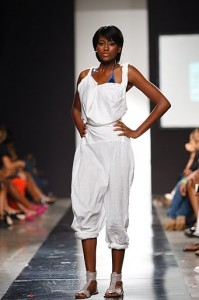 Instead we should first ask, “How can we get access (in our current state)?” Also, and possibly most important is, we must recognize that what we do has value. The smart options he presented were the development of high-end niche markets; develop interesting stories around our products, and ensure the quality is high. The key however is the reinvestment of profits and stemming the tide so common in industries in the Caribbean – that of flight of capital. What is needed is a revolution of the mind; in that we not only actively support local industries but in turn local employers pay staff better and where applicable explore the option of employees being part owners in the bran. Invest in real economies, instead of more abstract industries such as speculations and futures, thus minimizing the effects of a collapse of such unstable markets for example the Cash Plus/ Olint fiasco that still plagues Jamaica. The key for Caribbean islands is to build and or rebuild tangible industries thus creating real employment opportunities, instead of seasonal ones. Thus making a strong foundation for future generations and making it more attractive for present ones to invest, also there is a great need to harness the strength of the Diaspora through networking.
Instead we should first ask, “How can we get access (in our current state)?” Also, and possibly most important is, we must recognize that what we do has value. The smart options he presented were the development of high-end niche markets; develop interesting stories around our products, and ensure the quality is high. The key however is the reinvestment of profits and stemming the tide so common in industries in the Caribbean – that of flight of capital. What is needed is a revolution of the mind; in that we not only actively support local industries but in turn local employers pay staff better and where applicable explore the option of employees being part owners in the bran. Invest in real economies, instead of more abstract industries such as speculations and futures, thus minimizing the effects of a collapse of such unstable markets for example the Cash Plus/ Olint fiasco that still plagues Jamaica. The key for Caribbean islands is to build and or rebuild tangible industries thus creating real employment opportunities, instead of seasonal ones. Thus making a strong foundation for future generations and making it more attractive for present ones to invest, also there is a great need to harness the strength of the Diaspora through networking.
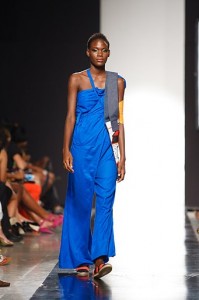 Young had a very pragmatic view of Caribbean leaders however, as he puts it “they are us.” Essentially our government deals with problems as we would in our limited experiences they try to make the best of what they have. They act only when there are accidents; it is through these accidents that set the wheels of change in motion. However, across the board respective Caribbean governments can assist in the stimulation of local industries by charging fewer taxes or even negative taxation on goods made and owned locally. His advice to upcoming designers is priceless. That is, they need not be intimidated by the colonizing nature of fashion instead he encourages them to use life experiences to find new ways of doing things. Inspiration proliferates our rich history and culture for example Johnkanoo, Marcus Garvey and even more contemporary figures such as Bob Marley may be used to develop original points of views. In essence use them as practice until you find your footing.
Young had a very pragmatic view of Caribbean leaders however, as he puts it “they are us.” Essentially our government deals with problems as we would in our limited experiences they try to make the best of what they have. They act only when there are accidents; it is through these accidents that set the wheels of change in motion. However, across the board respective Caribbean governments can assist in the stimulation of local industries by charging fewer taxes or even negative taxation on goods made and owned locally. His advice to upcoming designers is priceless. That is, they need not be intimidated by the colonizing nature of fashion instead he encourages them to use life experiences to find new ways of doing things. Inspiration proliferates our rich history and culture for example Johnkanoo, Marcus Garvey and even more contemporary figures such as Bob Marley may be used to develop original points of views. In essence use them as practice until you find your footing.
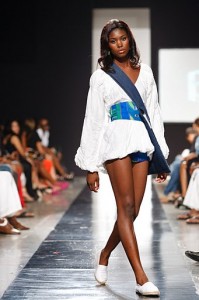 Finally, Yong cautions that while “fashion is a dream space” it can quickly become a nightmare when designers misread the context or do very little in analysis of the message that their garments convey. Therefore a well-made dress in good fabric can send the message that the wearer is a whore when it was not the intention of the designer. This is the result when we perpetuate ideas, which we do not understand, or have any practical use for (for example a winter line in a tropical marine climate). One of the more entertaining statements made by Young during the interview was; “If I could do what I want with these girls from Jamaica I would pull out all their weaves.” While very hilarious to imagine, (and a dangerous road for him to venture-women here are very serious about their weaves) it strikes at the core of us as a people missing the bigger picture, in what is fashionable and the disconnect of who we are. We constantly miss the value and beauty that we already posses, opting to replace the tangible and beauty concentrated with flash.
Finally, Yong cautions that while “fashion is a dream space” it can quickly become a nightmare when designers misread the context or do very little in analysis of the message that their garments convey. Therefore a well-made dress in good fabric can send the message that the wearer is a whore when it was not the intention of the designer. This is the result when we perpetuate ideas, which we do not understand, or have any practical use for (for example a winter line in a tropical marine climate). One of the more entertaining statements made by Young during the interview was; “If I could do what I want with these girls from Jamaica I would pull out all their weaves.” While very hilarious to imagine, (and a dangerous road for him to venture-women here are very serious about their weaves) it strikes at the core of us as a people missing the bigger picture, in what is fashionable and the disconnect of who we are. We constantly miss the value and beauty that we already posses, opting to replace the tangible and beauty concentrated with flash.
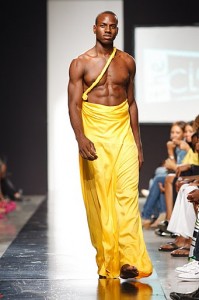 With all that’s said what other designers do Robert Young like? He mentioned Biggy because of his keen understanding of his niche. Japanese designers such as Issey Myake, Yohji Yamamoto and Comme des Garçons, his contemporaries who always seem to shine a new creative light on concepts we think we know. This year The Cloth celebrates 25 year of hard work and timeless designs (for example the T.V. Tee-shirt) Tsh5. Stop by their facebook page to see upcoming events and also to order must have pieces. For those in Jamaica the only place to get designs by the Cloth is Kerry ManWomanHome (1876-929-2096).
With all that’s said what other designers do Robert Young like? He mentioned Biggy because of his keen understanding of his niche. Japanese designers such as Issey Myake, Yohji Yamamoto and Comme des Garçons, his contemporaries who always seem to shine a new creative light on concepts we think we know. This year The Cloth celebrates 25 year of hard work and timeless designs (for example the T.V. Tee-shirt) Tsh5. Stop by their facebook page to see upcoming events and also to order must have pieces. For those in Jamaica the only place to get designs by the Cloth is Kerry ManWomanHome (1876-929-2096).
Read the rest of "The Cloth – 25 and going strong." →
posted on April 27th, 2010 by Eve in Article, Mann´s World
 So much drama in the industry today it just feels like never ending waves of negative energy seems poised to destroy what so many worked so hard to built. The thing about energy is you get back what you give. That much one would think is common knowledge.
So much drama in the industry today it just feels like never ending waves of negative energy seems poised to destroy what so many worked so hard to built. The thing about energy is you get back what you give. That much one would think is common knowledge.
Therefore it would be irresponsible for anyone to pretend that the present miasma of bad news that hovers so thick over the landscape on the verge of suffocating the economic livelihood of those directly and indirectly involved in the industry has nothing to do with the actions of its actors.
For instance Ricky Trooper should be happy that the only visa that got revoked was the one from America. For some reason Jamaicans seem to think that a U. S. visa is a right. We forget that the only country obligated to put up with our nasty behavior no matter what is the one we spit on constantly i.e. Jamaica. Everyday the world gets smaller and markets more competitive. Therefore no matter how drunk Trooper was, waving a gun and demonstrating how bad the affliction of verbal diarrhea affects him on camera would be the definition of career suicide. Recently Trooper was On Stage with Winford Williams saying that’s just another gimmick and the gun was fake or not loaded, whatever. Stating him good wid everybody and everybody good wid him.
Read the rest of "Who Murder the Music" →
posted on November 10th, 2009 by Eve in Mann´s World, Stuff

Recently I stood in Half Way Tree in an eternally long ABM line. Observing the traffic both on the road and in the plaza (mall) and realized that Christmas was upon us. In light of that I figured I would share a few of my mother’s and other women I know with really great Christmas recipes. Fruitcakes are an integral part of the Jamaican Christmas experience. Even in houses where mommies didn’t bake or cook for that matter, they always had cakes and sorrel at home for when the inevitable visitors stopped by. I still have fond childhood memories of being the official mixer, to which I always got a stern warning every year.
“Nuh change the direction yu a mix in or yu a go spoil mi cake!”
Read the rest of "Mom’s Jamaican Christmas Fruitcake Recipe" →
 Clearly, Jamaica has a growing culture of latent homosexuals of both male and female. They outwardly seek the company of the same sex, however, due to fear of societal rejection and or the promise of violence they never fully embark in an out of the closet gay relationship. Instead they opt for a more socially accepted version. Therefore, women embark in relationships with men who act and dress in a more female manner. Outwardly the »men« are very in-tuned with their femininity (in the wrong way), they display very »delicate« mannerisms and do everything from bleaching, eyebrow arching and even forgoing male scents opting instead for a flowery perfume instead of a woody male cologne. To fill the void women tend to take a more dominant role and while they may still dress like females their roles have now become that of protector and provider in the relationship. Financially, emotionally and at times physically they do everything in the relationship that the quintessential male figure should do, including but not limited to providing money, directly or indirectly to buy bleaching cream and Clarks and/or walking on the outside during their strolls a position usually only occupied by a true gentleman. Essentially perpetuating a »Mine mi fe wine mi« culture. Something once only a certain class of females would have the audacity to admit to. But instead now in songs like Clarks II Vybz Kartel proudly states
Clearly, Jamaica has a growing culture of latent homosexuals of both male and female. They outwardly seek the company of the same sex, however, due to fear of societal rejection and or the promise of violence they never fully embark in an out of the closet gay relationship. Instead they opt for a more socially accepted version. Therefore, women embark in relationships with men who act and dress in a more female manner. Outwardly the »men« are very in-tuned with their femininity (in the wrong way), they display very »delicate« mannerisms and do everything from bleaching, eyebrow arching and even forgoing male scents opting instead for a flowery perfume instead of a woody male cologne. To fill the void women tend to take a more dominant role and while they may still dress like females their roles have now become that of protector and provider in the relationship. Financially, emotionally and at times physically they do everything in the relationship that the quintessential male figure should do, including but not limited to providing money, directly or indirectly to buy bleaching cream and Clarks and/or walking on the outside during their strolls a position usually only occupied by a true gentleman. Essentially perpetuating a »Mine mi fe wine mi« culture. Something once only a certain class of females would have the audacity to admit to. But instead now in songs like Clarks II Vybz Kartel proudly states
 Some days I feel like Rip Van Winkle. I fell asleep for too long and woke up in a strange time warp where nothing makes sense. To be honest I feel like that old man shaking his fist saying, ‘Hey you crazy kids turn that garbage off and pull your pants up!’
Some days I feel like Rip Van Winkle. I fell asleep for too long and woke up in a strange time warp where nothing makes sense. To be honest I feel like that old man shaking his fist saying, ‘Hey you crazy kids turn that garbage off and pull your pants up!’ What do you get when you cross an agricultural student, a nationalist and a designer? I don’t know either, but at some point in his life those labels stuck to The Cloth’s founder/designer Robert Young. While the name Robert Young and The Cloth may not be as household as that of a Prada or Moschino there is no denying the quality, innovation and strict attention to detail demonstrated by the line, which would rival the more popular global counterparts. The name emerged from a clever play on words of Young’s early fascination with the perks of the priesthood which at the time included a among other things a nice house along the Savannah in Port of Spain. Young states, “I am an artist that works with clothes.” It is very easy to see this in his line, as many pieces (Jackets, jumpers, bags etc.) while very wearable feel suited to be framed and hung at a focal point to be a topic of discussion.
What do you get when you cross an agricultural student, a nationalist and a designer? I don’t know either, but at some point in his life those labels stuck to The Cloth’s founder/designer Robert Young. While the name Robert Young and The Cloth may not be as household as that of a Prada or Moschino there is no denying the quality, innovation and strict attention to detail demonstrated by the line, which would rival the more popular global counterparts. The name emerged from a clever play on words of Young’s early fascination with the perks of the priesthood which at the time included a among other things a nice house along the Savannah in Port of Spain. Young states, “I am an artist that works with clothes.” It is very easy to see this in his line, as many pieces (Jackets, jumpers, bags etc.) while very wearable feel suited to be framed and hung at a focal point to be a topic of discussion.  In 1986 Robert Young along with artists Nathalie Phillips, Adel Todd and Camille Selvon out of necessity began pushing the boundaries of the clothing technology available by working and reworking designs. Printing, painting and making meaningful garments that they felt that could not be replicated by anyone else. The women would later move on to other projects and school respectively. With over 24 years in the business it is safe to say that Young is an expert when it comes to his chosen craft of fashion, design and clothing, he loves
In 1986 Robert Young along with artists Nathalie Phillips, Adel Todd and Camille Selvon out of necessity began pushing the boundaries of the clothing technology available by working and reworking designs. Printing, painting and making meaningful garments that they felt that could not be replicated by anyone else. The women would later move on to other projects and school respectively. With over 24 years in the business it is safe to say that Young is an expert when it comes to his chosen craft of fashion, design and clothing, he loves  1997 Young had a show called ‘No Chorus Yet’. This intrinsically meant, “I have no definite way of doing anything yet!” Watching his show one would find that very hard to believe. As over the years the Cloth has become known for its unique shows, like opting for a live band to play in the centre stage during a show. This years Caribbean Fashion Week was no different. While all other designers had their models stomping the runway to the sound of over played and meaningless tunes, models for the Cloth walked pensively to the sound of a river meandering the runway mimicking the flow of water. As Young admits, “I have always had a story but the (design) process came about clumsily.”
1997 Young had a show called ‘No Chorus Yet’. This intrinsically meant, “I have no definite way of doing anything yet!” Watching his show one would find that very hard to believe. As over the years the Cloth has become known for its unique shows, like opting for a live band to play in the centre stage during a show. This years Caribbean Fashion Week was no different. While all other designers had their models stomping the runway to the sound of over played and meaningless tunes, models for the Cloth walked pensively to the sound of a river meandering the runway mimicking the flow of water. As Young admits, “I have always had a story but the (design) process came about clumsily.”  At the end of the show instead of doing the customary walk of the designer trailing his designs Mr. Young had something more substantial than a wave and smile. Amid much microphone trouble the message was not lost. He said, “We cannot move forward if you don’t buy your own”. But how do we move forward? How do we move the Caribbean fashion industry from a third world odd ball to a first world fashion mainstay? Young confesses that it is not for his generation but for the ones coming up as much is currently lacking. Issues such as adequate capital to make economies of scale a sensible and profitable option or the ability to mass-produce to rival larger markets inhibit today’s Caribbean designers.
At the end of the show instead of doing the customary walk of the designer trailing his designs Mr. Young had something more substantial than a wave and smile. Amid much microphone trouble the message was not lost. He said, “We cannot move forward if you don’t buy your own”. But how do we move forward? How do we move the Caribbean fashion industry from a third world odd ball to a first world fashion mainstay? Young confesses that it is not for his generation but for the ones coming up as much is currently lacking. Issues such as adequate capital to make economies of scale a sensible and profitable option or the ability to mass-produce to rival larger markets inhibit today’s Caribbean designers.  Instead we should first ask, “How can we get access (in our current state)?” Also, and possibly most important is, we must recognize that what we do has value. The smart options he presented were the development of high-end niche markets; develop interesting stories around our products, and ensure the quality is high. The key however is the reinvestment of profits and stemming the tide so common in industries in the Caribbean – that of flight of capital. What is needed is a revolution of the mind; in that we not only actively support local industries but in turn local employers pay staff better and where applicable explore the option of employees being part owners in the bran. Invest in real economies, instead of more abstract industries such as speculations and futures, thus minimizing the effects of a collapse of such unstable markets for example the Cash Plus/ Olint fiasco that still plagues Jamaica. The key for Caribbean islands is to build and or rebuild tangible industries thus creating real employment opportunities, instead of seasonal ones. Thus making a strong foundation for future generations and making it more attractive for present ones to invest, also there is a great need to harness the strength of the Diaspora through networking.
Instead we should first ask, “How can we get access (in our current state)?” Also, and possibly most important is, we must recognize that what we do has value. The smart options he presented were the development of high-end niche markets; develop interesting stories around our products, and ensure the quality is high. The key however is the reinvestment of profits and stemming the tide so common in industries in the Caribbean – that of flight of capital. What is needed is a revolution of the mind; in that we not only actively support local industries but in turn local employers pay staff better and where applicable explore the option of employees being part owners in the bran. Invest in real economies, instead of more abstract industries such as speculations and futures, thus minimizing the effects of a collapse of such unstable markets for example the Cash Plus/ Olint fiasco that still plagues Jamaica. The key for Caribbean islands is to build and or rebuild tangible industries thus creating real employment opportunities, instead of seasonal ones. Thus making a strong foundation for future generations and making it more attractive for present ones to invest, also there is a great need to harness the strength of the Diaspora through networking.  Young had a very pragmatic view of Caribbean leaders however, as he puts it “they are us.” Essentially our government deals with problems as we would in our limited experiences they try to make the best of what they have. They act only when there are accidents; it is through these accidents that set the wheels of change in motion. However, across the board respective Caribbean governments can assist in the stimulation of local industries by charging fewer taxes or even negative taxation on goods made and owned locally. His advice to upcoming designers is priceless. That is, they need not be intimidated by the colonizing nature of fashion instead he encourages them to use life experiences to find new ways of doing things. Inspiration proliferates our rich history and culture for example Johnkanoo, Marcus Garvey and even more contemporary figures such as Bob Marley may be used to develop original points of views. In essence use them as practice until you find your footing.
Young had a very pragmatic view of Caribbean leaders however, as he puts it “they are us.” Essentially our government deals with problems as we would in our limited experiences they try to make the best of what they have. They act only when there are accidents; it is through these accidents that set the wheels of change in motion. However, across the board respective Caribbean governments can assist in the stimulation of local industries by charging fewer taxes or even negative taxation on goods made and owned locally. His advice to upcoming designers is priceless. That is, they need not be intimidated by the colonizing nature of fashion instead he encourages them to use life experiences to find new ways of doing things. Inspiration proliferates our rich history and culture for example Johnkanoo, Marcus Garvey and even more contemporary figures such as Bob Marley may be used to develop original points of views. In essence use them as practice until you find your footing.  Finally, Yong cautions that while “fashion is a dream space” it can quickly become a nightmare when designers misread the context or do very little in analysis of the message that their garments convey. Therefore a well-made dress in good fabric can send the message that the wearer is a whore when it was not the intention of the designer. This is the result when we perpetuate ideas, which we do not understand, or have any practical use for (for example a winter line in a tropical marine climate). One of the more entertaining statements made by Young during the interview was; “If I could do what I want with these girls from Jamaica I would pull out all their weaves.” While very hilarious to imagine, (and a dangerous road for him to venture-women here are very serious about their weaves) it strikes at the core of us as a people missing the bigger picture, in what is fashionable and the disconnect of who we are. We constantly miss the value and beauty that we already posses, opting to replace the tangible and beauty concentrated with flash.
Finally, Yong cautions that while “fashion is a dream space” it can quickly become a nightmare when designers misread the context or do very little in analysis of the message that their garments convey. Therefore a well-made dress in good fabric can send the message that the wearer is a whore when it was not the intention of the designer. This is the result when we perpetuate ideas, which we do not understand, or have any practical use for (for example a winter line in a tropical marine climate). One of the more entertaining statements made by Young during the interview was; “If I could do what I want with these girls from Jamaica I would pull out all their weaves.” While very hilarious to imagine, (and a dangerous road for him to venture-women here are very serious about their weaves) it strikes at the core of us as a people missing the bigger picture, in what is fashionable and the disconnect of who we are. We constantly miss the value and beauty that we already posses, opting to replace the tangible and beauty concentrated with flash.  With all that’s said what other designers do Robert Young like? He mentioned Biggy because of his keen understanding of his niche. Japanese designers such as Issey Myake, Yohji Yamamoto and Comme des Garçons, his contemporaries who always seem to shine a new creative light on concepts we think we know. This year The Cloth celebrates 25 year of hard work and timeless designs (for example the T.V. Tee-shirt) Tsh5. Stop by their facebook page to see upcoming events and also to order must have pieces. For those in Jamaica the only place to get designs by the Cloth is Kerry ManWomanHome (1876-929-2096).
With all that’s said what other designers do Robert Young like? He mentioned Biggy because of his keen understanding of his niche. Japanese designers such as Issey Myake, Yohji Yamamoto and Comme des Garçons, his contemporaries who always seem to shine a new creative light on concepts we think we know. This year The Cloth celebrates 25 year of hard work and timeless designs (for example the T.V. Tee-shirt) Tsh5. Stop by their facebook page to see upcoming events and also to order must have pieces. For those in Jamaica the only place to get designs by the Cloth is Kerry ManWomanHome (1876-929-2096). So much drama in the industry today it just feels like never ending waves of negative energy seems poised to destroy what so many worked so hard to built. The thing about energy is you get back what you give. That much one would think is common knowledge.
So much drama in the industry today it just feels like never ending waves of negative energy seems poised to destroy what so many worked so hard to built. The thing about energy is you get back what you give. That much one would think is common knowledge. 
